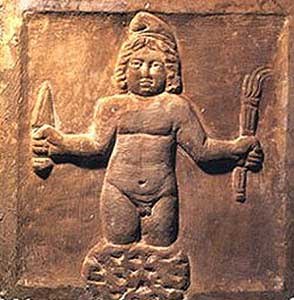 The Christmas season is here, and with it the remembrance of Jesus’ birth and His redemptive purposes for mankind. This is the time of year where we Christians celebrate the moment God took on flesh in order to redeem His people. This is why the angels declared “Glory to God in the highest, and on earth peace among men with whom He is pleased” (Luke 2:14). For some non-believers this is the time of year to cry foul on Jesus’ birth narrative. They say the story was really borrowed from previous myths. Specifically, certain elements of the story, like God becoming flesh, being born of a virgin, a star in the east marking the occasion, etc., were taken from the origin stories of the likes of Horus or Mithra(s). A well-known internet film called “Zeitgeist” is probably to blame for these current claims.
The Christmas season is here, and with it the remembrance of Jesus’ birth and His redemptive purposes for mankind. This is the time of year where we Christians celebrate the moment God took on flesh in order to redeem His people. This is why the angels declared “Glory to God in the highest, and on earth peace among men with whom He is pleased” (Luke 2:14). For some non-believers this is the time of year to cry foul on Jesus’ birth narrative. They say the story was really borrowed from previous myths. Specifically, certain elements of the story, like God becoming flesh, being born of a virgin, a star in the east marking the occasion, etc., were taken from the origin stories of the likes of Horus or Mithra(s). A well-known internet film called “Zeitgeist” is probably to blame for these current claims.
However, the idea that Jesus’ story was taken from previous myths is rather old, and is still just as false today as it was back then. There are a couple of reasons[1] for this: First, the so-called similarities between myth and Christian narrative are not as similar as non-believers claim; Second, the overall claim is rife with logical fallacies including the terminology fallacy, chronological fallacy, and post hoc, ergo propter hoc (or after this, therefore because of this). This post will unpack these two reasons as they intersect with Horus and Mithra(s).
Alleged Similarities
 Horus: According to the “Zeitgeist” film, “Horus was born on December 25th of the virgin Isis-Meri. His birth was accompanied by a star in the east, which in turn, three kings followed to locate and adorn the new-born savior. At the age of 12, he was a prodigal child teacher, and at the age of 30 he was baptized by a figure known as Anup and thus began his ministry. Horus had 12 disciples he traveled about with performing miracles such as healing the sick and walking on water… After being betrayed by Typhon, Horus was crucified, buried for 3 days, and thus resurrected.”[2]
Horus: According to the “Zeitgeist” film, “Horus was born on December 25th of the virgin Isis-Meri. His birth was accompanied by a star in the east, which in turn, three kings followed to locate and adorn the new-born savior. At the age of 12, he was a prodigal child teacher, and at the age of 30 he was baptized by a figure known as Anup and thus began his ministry. Horus had 12 disciples he traveled about with performing miracles such as healing the sick and walking on water… After being betrayed by Typhon, Horus was crucified, buried for 3 days, and thus resurrected.”[2]
There are 10 elements to consider here: Born of a virgin, born on December 25th, star in the east, three kings, baptism, ministry, 12 disciples, miracles, crucifixion, and resurrection. Put together as such, it sounds pretty convincing, until one looks at the historical documents of the Horus myth.[3] There are two important things to note at the outset. First, a number of these “similarities” are based on alleged details of Horus’ story that have no evidence to support them. For example, the claim that Horus’ story included a star in the east marking his birth, three kings, and the moniker “new-born savior” can’t be found anywhere in the source materials. Also, the claim that he was a child teacher or that he was baptized at age 30, had a “ministry”, and walked on water cannot be supported by any historical reference. These are all simply bald assertions.
Second, Horus’ story is difficult to piece together because two versions of his story developed and merged in Egyptian history. On the one hand, Horus #1 is the Sun-god, on the other Horus #2 is the child of Isis and Osiris. There are a number of variations of Horus’ birth. One has brother-and-sister gods Osiris and Isis having intercourse and conceiving Horus in the womb of Nut (their mother). Another entails Isis having intercourse with Osiris’ dead body. None of the versions of the myth portray Isis as a virgin. There also is no evidence that Horus’ birth was celebrated on December 25th; it was likely celebrated by the Egyptians in August. It is also not true, as proponents of this view hold, that the Bible or early Christianity records Jesus’ birth on December 25th. The December 25th date was assigned several hundred years after Christ, and even then it is unclear that Christians really believed that December 25th was the actual date of Jesus’ birth.
 Mithra: According to The Mysteries of Mithras: The Pagan Belief that Shaped the Christian World by Payam Nabarz, “The Persian Mithra was born of the immaculate virgin Mother Goddess Anahita… This birth took place in a cave or grotto, where shepherds attended him and presented him with gifts at the winter solstice. Mithra lived for sixty-four years and then ascended to heaven in 208 B.C.E.”[4] Mithra(s) also, according to the “Zeitgeist” film, was born on December 25th, had twelve disciples, and died and resurrected.
Mithra: According to The Mysteries of Mithras: The Pagan Belief that Shaped the Christian World by Payam Nabarz, “The Persian Mithra was born of the immaculate virgin Mother Goddess Anahita… This birth took place in a cave or grotto, where shepherds attended him and presented him with gifts at the winter solstice. Mithra lived for sixty-four years and then ascended to heaven in 208 B.C.E.”[4] Mithra(s) also, according to the “Zeitgeist” film, was born on December 25th, had twelve disciples, and died and resurrected.
Much like the story of Horus, it should be noted that there are no substantive accounts of the story of Mithra(s). As a matter of fact, there are no actual texts for Mithraism. Rather, there are elements here and there that historians (and other ancient writers, all post-first century) have attempted to piece together from inscriptions, images, and places of worship. The claim by Nabarz that Mithra’s birth was an immaculate conception by the virgin goddess Anahita is supposedly taken from an inscription at a temple in Iran from 200 B.C. that reads Anahita, the Immaculate Virgin Mother Goddess of the Lord Mithra. In actuality the temple was determined to have been constructed centuries after Christ, not before. And there is no substantiated, scholarly source that the inscription of Anahita as Mithra’s mother actually exists, just the claim itself repeated ad infinitum by Nabarz and proponents of this view on the internet. As a matter of fact, there is better evidence that Anahita was Mithra’s companion rather than his mother.
According to the Roman version of the myth, Mithras was born, as an adult, from a rock, not even close to the account of Jesus being born as a baby from a virgin by any stretch of the imagination. While it is true that two torchbearers, Cautes and Cautopates, helped Mithras emerge from the rock after being “born”, it is not clear how they can be considered “shepherds”, as Nabarz (and others) claims. There also is no evidence to support the notion that, as “Zeitgeist” claims, Mithras was born on December 25th, had twelve disciples, and died and resurrected. Not only is there is no good evidence[5] that Sol Invictus was celebrated on December 25th, there is no evidence that Mithras was the god being celebrated during Sol Invictus.[6] The only thing associated with Mithras and the number twelve are the twelve signs of the zodiac found in a number of mithraems (or places of worship). Finally, there is zero evidence that Mithra(s) ever died in the myth; and if there is no death, there can be no resurrection.
Logical Fallacies
 It should be obvious by now that much of the so-called “similarities” between Jesus, Horus, and Mithra(s) are not really similarities at all, and the rest are simply made up out of whole cloth. False “similarities” are not the only thing wrong with these kinds of claims. In order to develop their argument, proponents of this view rely on fallacious reasoning.
It should be obvious by now that much of the so-called “similarities” between Jesus, Horus, and Mithra(s) are not really similarities at all, and the rest are simply made up out of whole cloth. False “similarities” are not the only thing wrong with these kinds of claims. In order to develop their argument, proponents of this view rely on fallacious reasoning.
Terminology Fallacy: The terminology fallacy is what Dr. Mark Foreman defines as people using “Christian terminology in order subtly to manipulate viewers into accepting that the same events in the life of Jesus also happened in the lives of mythical gods.”[7] For example, we are told that Horus was born of a “virgin”. But when we go back to the literature we discover that Isis is not a virgin at all. Therefore, the term “virgin” has been used to connote Christian concepts and give the appearance of similarity. This is also seen with the use of terms like “savior”, disciples”, “crucifixion”, “resurrection”, etc. None of these terms (and those like them) bear the characteristic mark of orthodox Christian teaching and, therefore, fall under the category of Foreman’s terminology fallacy.
Chronological Fallacy: In order for the claim that Christianity borrowed from previous myth to get off the ground the evidence for the myth must chronologically precede Christianity. But this is not the case. Either the so-called parallel claims are based on sources that come after the inception and early development of Christianity (like the 3rd, 4th, and 5th centuries A.D.) or some of the mystery religions themselves developed after Christianity (e.g. Appolonius of Tyanna). On this issue Ronald Nash writes, “Far too many writers on the subject use the available sources to form the plausible reconstructions of the third-century mystery experience and then uncritically reason back to what they think must have been the earlier nature of the cults.”[8] In other words, considering the vast variations between versions of a particular myth (like Horus or Mithra), the important differences between a religion and its earlier, ancient expression, as well as the lack of evidence to support a consistent mythology through history, it is foolish to draw the particular kinds of conclusions about them that many proponents do.
Post Hoc, Ergo Propter Hoc: To commit a post hoc fallacy one must suggest that two events in close temporal proximity are causally related. In other words Story #1 came before Story #2, therefore Story #1 caused Story #2. Let’s grant for argument’s sake (despite the evidence to the contrary) that the story of Horus being born of a virgin actually did precede the story of Jesus’ birth. To conclude, therefore, that the story of Jesus is stolen from the story of Horus is to do so on the basis of no positive argument or evidence. It is merely speculation to assert a causal claim between the two; and, as I mentioned, a speculation is not evidence. Thus, to point out (as proponents do) that this or that element of a myth preceded Christianity is not an argument, and, thus, should not be persuasive when considering this issue.
Conclusion
 The so-called parallels between Jesus and earlier myth need a strong foundation in historical source documents as well as an argument free of fallacies, neither of which they possess. Unfortunately, while the weaknesses are such that scholars no longer find this issue plausible, some folks unaware of current scholarship continue to be taken in by this nonsense. However, those looking to think critically should always remember to go back to the historical documents. The answers can usually be found in the homework.
The so-called parallels between Jesus and earlier myth need a strong foundation in historical source documents as well as an argument free of fallacies, neither of which they possess. Unfortunately, while the weaknesses are such that scholars no longer find this issue plausible, some folks unaware of current scholarship continue to be taken in by this nonsense. However, those looking to think critically should always remember to go back to the historical documents. The answers can usually be found in the homework.
[1] There are actually a number of other reasons that cannot be articulated for the purposes of this post. A couple of great resources to go deeper into this issue are: 1) “Does the Story of Jesus Mimic Pagan Mystery Stories?” by Mary Jo Sharp in Come Let Us Reason; 2) “Considerations of Methodology in the Study of the Mystery Religions and Early Christianity” by Bruce F. Metzger. The former is a nice primer on the issue. The latter is a thorough, more academic, exposition.
[2] Joseph, Peter. “Zeitgeist: The Movie.” Zeitgeist: The Movie. 2007. Accessed December 24, 2015. http://www.zeitgeistmovie.com/.
[3] Some good texts to look at are E.A. Wallis Budge’s translation of the Book of the Dead, Plutarch’s “Concerning Isis and Osiris”, David Ulansey’s The Origins of the Mithraic Mysteries, and Franz Cumont’s The Mysteries of Mithra: The Origins of Mithraism.
[4] Nabarz, Payam, The Mysteries of Mithras: The Pagan Belief that Shaped the Christian World (Rochester, VT: Inner Traditions), 19.
[5] There is a calendar of official festivals of Rome for the year 354 A.D. that includes reference to the birthday of Invictus. But, as Steven Hijman points out, the term Invictus, in and of itself, is not exclusive to Sol.
[6] For more on this see “Usener’s Christmas: A Contribution to the Modern Construct of Late Antique Solar Syncretism” by Steven Hijman in Hermann Usener und die Metamorphosen der Philologie.
[7] Foreman, Mark. “Challenging the Zeitgeist Movie: Parallelomania on Steriods” in Come Let Us Reason, eds. Paul Copan and William Lane Craig (Nashville, TN: B&H Publishing, 2012) Kindle edition.
[8] Nash, Ronald H. The Gospel and the Greeks: Did the New Testament Borrow from Pagan Thought? (Phillipsburg, NJ: P& R Publishing, 2003), 116.






